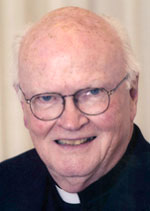As an octogenarian, I’ve witnessed the rise and am beginning to see the fall of professional, call it commercial, football in the United States. The fan base is so strong and the commercial impact so widespread that the fall may not happen. But it could.
Concussions and other serious injuries are a major concern; prominent players are being charged with violence against women and children. Embattled NFL Commissioner Roger Goodell is on the defensive.
Back in the late summer of 1944, my St. Joseph’s Prep football teammates and I, along with the Philadelphia Eagles, spent two weeks outside of Philadelphia at what was then known as West Chester State Teachers College, now West Chester University. We were there for “football camp.” The Eagles had the lower-level floors in a college dorm; the high school boys occupied the upper floors. We all ate in the same dining hall.
We high school kids went through drills in full equipment each morning; the Eagles worked out in shorts and T-shirts. We scrimmaged in the afternoon; they were free, so many of them came out to offer coaching tips — their ends with our ends, their backs with our backs, their linemen with ours. Then at night, they scrimmaged under the lights and we watched. We learned a lot about football from them.
[hotblock]
It was a big deal for us to be around Jack Banta, Enio Conti, Jack Ferrante, Jack Hinkle, Francis “Bucko” Kilroy, Ben Kish, Eddie Michaels (who never wore a helmet!), Allie Sherman (who was only 21), Steve Van Buren and Al Wistert. There were 31 players on the Eagles’ roster. For all of them, it was a part-time job. None of them earned anything in the vicinity of a six-figure salary.
No one ever suggested that these pros were not good role models for we boys. There were no reports of spouse abuse or other behavioral problems on their part. Coach Greasy Neale had them toe the line on field and off. They finished second in the NFL Eastern Division that year. There was no Super Bowl back then.
Things are different now. Goodell, shamed into a September news conference, publicly apologized for oversight failures and acknowledged the need to repair off-the-field conduct policies. He announced that he would appoint a committee to overhaul the league’s personal conduct policy and will have a report ready by Super Bowl Sunday. Many wonder, why not sooner?
Professional football (no reason not to call it “commercial football”) is a major business that, without intending to, holds a mirror up to American culture. From high-priced stadium seats or in front of generously sponsored television coverage, we delight in watching organized violence on fall Sunday afternoons and a couple of weekday nights through autumn into January.
The heaviest Eagle I saw back in 1944 was Bucko Kilroy (243 pounds), and the tallest, only one, was rookie John Durko (6 feet 4). Today’s rosters far exceed earlier height and weight totals thus helping to explain why virtually one out of every three players now will have a short career and lifelong injuries.
Most of us will continue to watch the games, although we may consume more of the advertised beverages to ease the guilt. Younger parents may begin to steer their male offspring away from the gridiron toward the soccer and lacrosse fields. Who knows? Only time will tell.
The long-overdue revision of personal conduct policies for NFL players may not be enough to save the game.
***
Jesuit Father William J. Byron is university professor of business and society at St. Joseph’s University, Philadelphia. Email: wbyron@sju.edu.




Father Byron raises the question whether Pro Football will survive. The morally more urgent question is whether scholastic football should be permitted to continue at Catholic affiliated high schools and colleges, in light of what is now known by the medical community concerning gridiron-related concussions. Boston University’s Center for the Study of Traumatic Encephalopathy (CSTE) has amassed a preponderance of scientific research that has gone well beyond mere correlation towards undisputed causation: indicting American football is a brain-killer.
The key point coming out of the CSTE study is that it is not just the concussions where the player loses consciousness, that are deleterious to cognitive function, but rather the accumulation of micro-traumas to the brain, which occur virtually every time that the opposing lines make contact, that overtime lead to irreversible brain damage to at least some degree in all participants.
Watching NFL coverage on TV from dawn to dusk on Sundays might only be a venial sin of sloth for the average fan (assuming he attended Mass on Saturday night), but surely academic authorities at Catholic-affiliated schools, who countenance minors engaging in an activity that damages their cognitive functions for life, are committing a mortal sin. Now that is an issue on which I would like to see Father Byron opine.